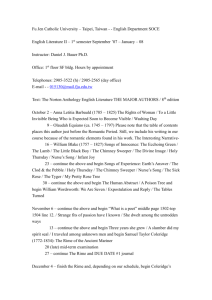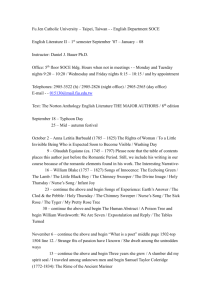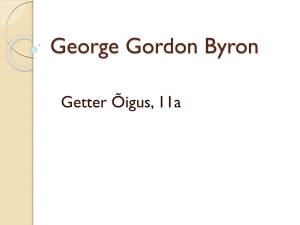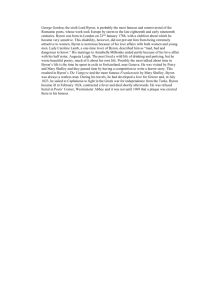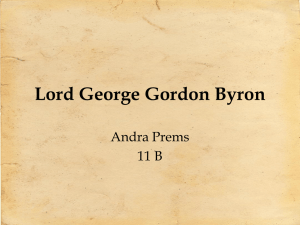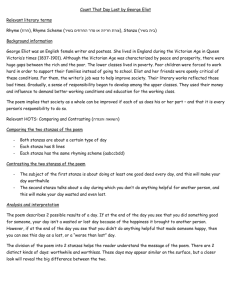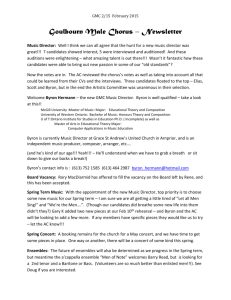Childe Harold by Lord Byron
advertisement
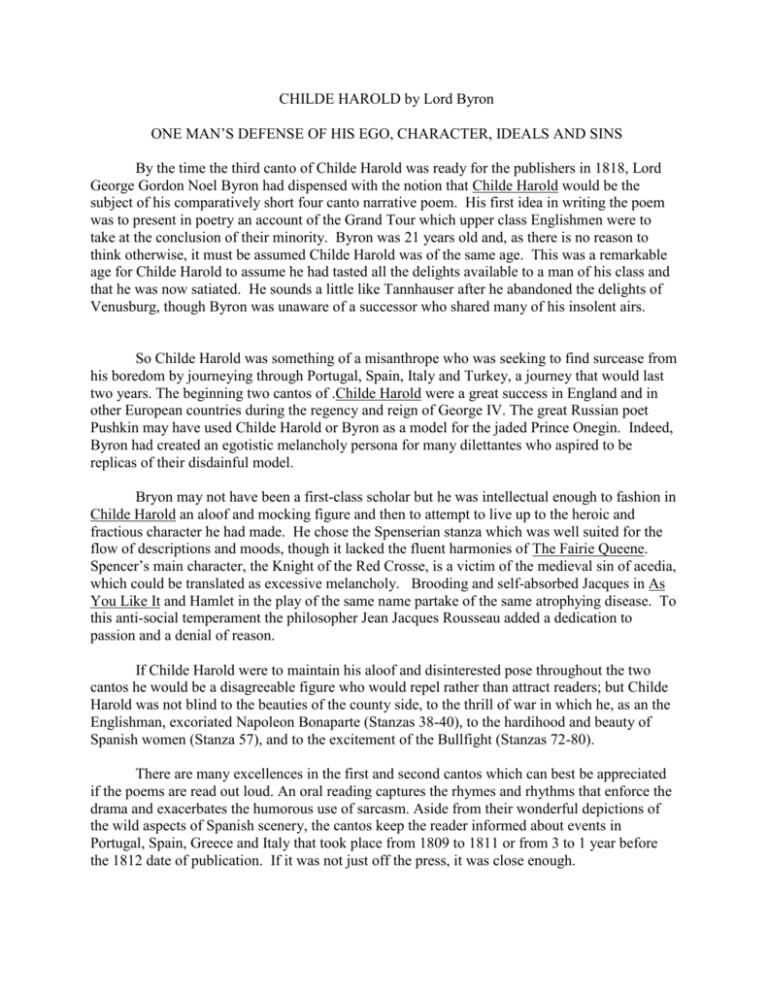
CHILDE HAROLD by Lord Byron ONE MAN’S DEFENSE OF HIS EGO, CHARACTER, IDEALS AND SINS By the time the third canto of Childe Harold was ready for the publishers in 1818, Lord George Gordon Noel Byron had dispensed with the notion that Childe Harold would be the subject of his comparatively short four canto narrative poem. His first idea in writing the poem was to present in poetry an account of the Grand Tour which upper class Englishmen were to take at the conclusion of their minority. Byron was 21 years old and, as there is no reason to think otherwise, it must be assumed Childe Harold was of the same age. This was a remarkable age for Childe Harold to assume he had tasted all the delights available to a man of his class and that he was now satiated. He sounds a little like Tannhauser after he abandoned the delights of Venusburg, though Byron was unaware of a successor who shared many of his insolent airs. So Childe Harold was something of a misanthrope who was seeking to find surcease from his boredom by journeying through Portugal, Spain, Italy and Turkey, a journey that would last two years. The beginning two cantos of .Childe Harold were a great success in England and in other European countries during the regency and reign of George IV. The great Russian poet Pushkin may have used Childe Harold or Byron as a model for the jaded Prince Onegin. Indeed, Byron had created an egotistic melancholy persona for many dilettantes who aspired to be replicas of their disdainful model. Bryon may not have been a first-class scholar but he was intellectual enough to fashion in Childe Harold an aloof and mocking figure and then to attempt to live up to the heroic and fractious character he had made. He chose the Spenserian stanza which was well suited for the flow of descriptions and moods, though it lacked the fluent harmonies of The Fairie Queene. Spencer’s main character, the Knight of the Red Crosse, is a victim of the medieval sin of acedia, which could be translated as excessive melancholy. Brooding and self-absorbed Jacques in As You Like It and Hamlet in the play of the same name partake of the same atrophying disease. To this anti-social temperament the philosopher Jean Jacques Rousseau added a dedication to passion and a denial of reason. If Childe Harold were to maintain his aloof and disinterested pose throughout the two cantos he would be a disagreeable figure who would repel rather than attract readers; but Childe Harold was not blind to the beauties of the county side, to the thrill of war in which he, as an the Englishman, excoriated Napoleon Bonaparte (Stanzas 38-40), to the hardihood and beauty of Spanish women (Stanza 57), and to the excitement of the Bullfight (Stanzas 72-80). There are many excellences in the first and second cantos which can best be appreciated if the poems are read out loud. An oral reading captures the rhymes and rhythms that enforce the drama and exacerbates the humorous use of sarcasm. Aside from their wonderful depictions of the wild aspects of Spanish scenery, the cantos keep the reader informed about events in Portugal, Spain, Greece and Italy that took place from 1809 to 1811 or from 3 to 1 year before the 1812 date of publication. If it was not just off the press, it was close enough. Canto 2 takes place mostly in Albania with references to locations in Greece and to contiguous ocean currents. Childe Harold continues to moan though this time his focus is on the pathos of history. He recalls the glories of Greece as these are inspired by the sight of ruins (Stanza 10) and by the presence of Turkish overlords (Stanza 73). Though he prefers solitude and claims he connects with nature by forsaking human company (Stanzas 25-27), he is not averse to occasional dalliances, but he finds infatuation a sorry condition which those who fancy themselves in love will soon regret (Stanza 35). In the 21st century it is hard to imagine that anybody would chose to live a life entirely devoted to the exploration and expression of their feelings, but in the 18th century feelings seemed to take over the minds not only of individuals but of entire nations, as witnessed by the French Revolution and by the rise and fall of Napoleon Bonaparte. Byron worked up considerable rage at the theft of the Elgin Marbles from Greece by Lord Elgin from 1801 to 1812 (Stanzas 11-15). The highlight Canto 2 is the meeting with Ali Pacha, a Moslem who ruled parts of Albania and Greece (Stanzas 56-72). As with the bullfight in Canto 1, violence is stressed this time not against animals but against human beings. The adrenalin rush of combat is brought out by a series of translations of fighting songs by the soldiers of Ali Pacha, as Harold heard them while witnessing a sword dance (Indented Stanzas 111). The publication of Cantos 1 and 2 made Byron famous in England and helped to swell his income, which was further increased when he sold the family castle at Newstead that branches of the Byron family had owned since the reign of Henry VIII. After a four-year stay in England during which he married a wealthy heiress with whom he had marital difficulties and a love affair with his step-sister, Byron left England for Switzerland, Italy and Greece. A possibility that Byron was attracted to people of the same sex may have been the determining factor for his exile for homosexuality in England at the time was a hanging offense. Of course, rumored sodomy with his wife did not entail a pat on the back. While he wrote many poems that tended to glorify an outcast and a heroic life, Chile Herald left a lingering impression because there were so many allusions to Byron’s private and troubled life. Most of Cantos 3 and 4 are written in the first person. The young and effete Childe Harold of Cantos 1 and 2 has joined the ranks of the unemployed. It is stanzas from Cantos 3 and 4 that are frequently anthologized. Though some readers and English teachers claim one should read all the stanzas, those that were not anthologized reveal in many ways why the weaknesses and lapses of their maker; sometimes it is faulty syntax, false rhymes, forced enjambments, crabbed construction, and contradictory logic. For the most part Byron’s meters are forceful and his rhymes expressive of the moods and meanings of the stanzas. Oral recitation should stress not only the graceful rhythms and calculated juxtapositions of emotions, but also those occasions when Byron raises his voice, sometimes to advantage and sometimes to disadvantage as when he labors to express what turns out to be a repetitious cliché. The archaisms, particular in Cantos 1 and 2, overwhelm the conversational and intimate tone the poet is seeking. Canto 3 contains a depiction of the prelude to the Battle of Waterloo or the great ball in Brussels that was interrupted by the cannon’s roar (Stanzas 21 - 22). This episode has attracted Thackeray in Vanity Fair and Thomas Hardy in The Dynasts. There follows descriptions of scenery and events along the Rhine River (Stanzas 46-51) which are interrupted by a four stanza letter of sorts to a woman in the poet’s homeland, now thought to be Augusta Leigh, the poet’s step sister (Indented stanzas 1-4). The verse picks up speed and vividness when Lake Leman (Lake Geneva) is approached (Stanza 68). The stanzas following contain stirring verses extolling nature which Byron thought could best be appreciated when one is alone. Stanza 72 is typical of the blissful sentiment of union with nature. Implicit in these lines is a dichotomy between spirit and flesh in which spirit, imbued with ethereal energies, escapes from the mortal coil of earthly longings. . All this rapturizing leads up to a tribute to the philosopher Jean Jacques Rousseau who Byron emulates (Stanzas 76-81). The Rhine shifts to the Rhone (Stanza 71) and Lake Leman becomes a powerful symbol which at night brings forth stars, thunder and lightning (Stanzas 85 - 92). For a while the storm and fury and the ensuing calmness are resolved into a love which encompasses the seer and the seen (Stanzas 98-103). Then the exaltation of feeling is forgotten as Byron pays tribute to Voltaire, master of irony and Rousseau’s antithesis (Stanzas 105-106). This is followed by an acknowledgement of the achievements of Edward Gibbons, the chronicler of the rise and fall of the Roman empire (Stanza 107), whose work will supply the undergirding for Canto 4. Having arrived in Italy (Italia), Byron concludes with lines expressing his love for his daughter who, despite their separation, he hopes will love him as he loves her (Stanza 115). While possessing vigor, especially in the energetic verses describing nature’s moods around Lake Leman, its evocation of the Battle of Waterloo and its praise of the willfulness of man as artist, as thinker and as conqueror, Canto 3 is desultory in spots and the transitions jump rather than walk. The poet expected the reader to piece together what is left unsaid or perhaps his mind did not work in linear fashion. Canto 4 is a revelation on the whole successful which contains the most memorable lines that Byron ever wrote. With 186 stanzas, not counting insertions, Canto 4 is the longest of the Cantos. It traverses Italy, contains references to parts of Switzerland and Greece, and has more meditative verse than precise descriptions. While Byron harkens back to Childe Harold in a concluding stanza, it is Byron himself rather than his alter ego who journeys from Venice to Rome with stops in Ferrara and Florence and allusions, which may indicate stops, in Arqua and Ravenna. Venetian stanzas set the mood (Stanzas 1-19). Unlike the nature emphasis of Canto 3, Byron is now looking at the works of man and trying to decide if he likes what he sees. He is aware in every city he visits of all that has been and finds in the decay of cities and empires causes for woe. Still there is undeniable beauty in sinking Venice. Byron is thankful that he can see Venice externally and internally, the internal part being foremost as Byron was a romantic poet, which means he sought hope within himself to rebuff the gloom and hostility of the world outside. One of the reasons Bryon was grateful to Venice, Florence and Rome is that they were the sources from which the writers Tully, Livy, Virgil, Tasso, Ariosto, Dante, Petrarch, and Boccaccio derived their inspiration; and, in doing so, bequeathed a sense of immortality to themselves and to the cities they loved or spurned. While Byron has some interesting words to say about the Medici Venus in Florence (Stanzas 49-52), they are perfunctory compared to his later descriptions of the Gladiator Stanzas 140-142), the Laocoön (Stanza 160), and Apollo Belvedere in Rome (Stanzas 161 - 163). It is in Rome Byron came under the spell of the Pantheon (Stanza 146), Hadrian’s “Mole”, reputed to be the Castle of St. Angelo (Stanza 152), and St. Peter’s Dome (Stanzas 153-159). Dispersed between his recital of the pathos and grandeur of ruins, of which the description of the Coliseum is the most striking, are pictures of natural scenes of beauty and energy, the most notable of these being a comparison of the Apennine range in Italy to the might of the Alps that he had described in the preceding canto (Stanza 73). Except for the cumulative ending in which effects form a crescendo of climaxes the natural setting as Byron saw it, somewhere between Florence and Rome, is so compelling that, like a piece of harmonious music, say Beethoven’s Sixth Symphony, one likes to go back over these stanzas. Among many superlative stanzas, the cataract stanzas are outstanding (Stanzas 69-70). Every so often Byron interrupted his learned commentary on Italy, past and present, to denounce his enemies in England, among whom his wife and her relatives are the most offensive. If it were not for the splendor of his verse and the power of his emotions, one could accuse Byron of whining in these passages. It is magnanimous and superficial of him to say he will curse his foes with forgiveness and love (Stanza 135). He meant neither. After seeing Apollo Belvedere (stanza 161) Byron slides into an abyss where he is about as pessimistic as he could be --- which was quite a bit (Stanzas 166-168). There follows a eulogy of Princess Charlotte, daughter of George IV, who, along with her stillborn son, died in childbirth (Stanzas 167-172). One could question why the princess deserved such praise until one reads in a note that poets in England were competing with one another to write verses about the tragic event. Rome recedes from the scene and the poet finds himself on Mount Alban which commands a view of the Italian coast (Stanza 175). There follows the most often quoted of Byron’s verses “There is a pleasure in the pathless woods” (Stanza 178) and ‘Roll on, thou deep and dark blue Ocean – roll!” (Stanzas 179-184). Then it is over as Childe Harold dressed in his “sandal-shoon and scallop-shell” bids farewell (Stanza 186). There are many themes in Canto IV which elaborate on those in Cantos 1 through 3. These are themes of love, which curiously is more Platonic than libertine; of decay and of death, which is more welcome than dreaded, of nature which staggers and glorifies the solitary beholder and of freedom. Byron’s few attempts to define freedom are almost pure Jean Jacques Rousseau: “man was born free but is everywhere in chains.” It is not clear how Byron related freedom to political conditions though he conceded that Italy and Greece were under the yoke of foreign domination and deplored Napoleon Bonaparte for being vain and egotistical. (Strange antipathy coming from Lord Byron!) His views of political conditions in England, as shown in this poem, were murky. He probably wished the English nobility, were more forgiving of his follies and weaknesses. As Byron died before he could help fight to liberate Greece from Turkish domination, this essay concludes with Byron’s praise of freedom as expressed in Canto IV. Though everything is doomed to failure and death, the urge to freedom, cannot be stopped (Stanza 98). So the dying Gaul Gladiator in Stanza 141 recalled a freedom he once had. Stanza 98 Yet, Freedom! yet thy banner, torn from flying. Streams like the thunder-storm against the wind; Thy trumpet voice, though broken now and dying, The loudest still the tempest leaves behind; The tree hath lost its blossoms, and the rind, Chopp’d by the axe, looks rough and little worth, But the sap lasts, and still the seed we find Sown deep, even in the bosom of the North; So shall a better spring less bitter fruit bring forth.
